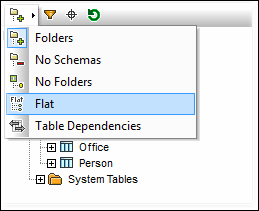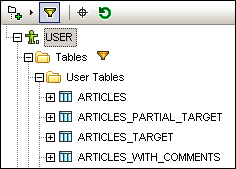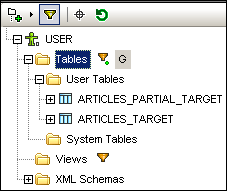Database Browser
This topic explains how to customize the display of the database tree, filter and search database objects. It also describes context menu options that are available for different database objects.
When you are connected to one or several databases, the Database Browser gives the full overview of the objects in each database, including tables, views, procedures, and so on. For databases with XML support, the Database Browser additionally shows registered XML schemas in a separate folder.
DB tree layouts
The Database Browser enables you to customize the display of the database tree. The predefined layouts are available at the top of the Database Browser (screenshot below).

To select a layout, click the ![]() (Folders Layout) button and select the required option from the list. Note that the button changes with the selected layout. The following options are available:
(Folders Layout) button and select the required option from the list. Note that the button changes with the selected layout. The following options are available:
•The Folders layout organizes database objects into folders based on the object type (default setting).
•The No Schemas layout is similar to the Folders layout, except that there are no database schema folders.
•The No Folders layout displays database objects in a hierarchy without using folders.
•The Flat layout displays database objects by type (e.g., all columns are displayed in a separate Columns folder).
•The Table Dependencies layout categorizes tables based on their relationships with other tables (e.g., tables with foreign keys, referenced tables).
In addition to layout navigation, you can use the Database Browser for the following tasks:
•Filtering and searching database objects (see subsections below)
•Sorting tables into System and User tables (see below)
•Refreshing the root object of the active data source (the ![]() button)
button)
To sort tables into User and System tables, right-click the Tables folder in the Database Browser and select Sort into User and System Tables from the context menu. This function is available when one of the following layouts is selected: Folders, No Schemas or Flat.
Filter database objects
You can filter any database objects (schemas, tables, views, etc.) by name or part of a name. Objects are filtered as you type in the characters. Filtering is case-insensitive by default. Filtering is not supported if you have selected the No Folders layout.
To filter database objects, take the following steps:
1.Click ![]() button at the top of the Database Browser. Filter icons appear next to all folders in the currently selected layout (screenshot below).
button at the top of the Database Browser. Filter icons appear next to all folders in the currently selected layout (screenshot below).

2.Click the filter icon next to the folder you want to filter and select the filtering option from the context menu (e.g., Contains).

3.Enter the search text (e.g., G) in the empty field which appears next to the filter icon. The results are adjusted as you type (screenshot below).

Search database objects
To find a specific database object, you can use the filtering functionality (see above) or the Object Locator. To find database objects using the Object Locator, follow the instructions below:
1.Click the ![]() button at the top of the Database Browser.
button at the top of the Database Browser.
2.Enter some search text in the text bar.
3.Press Enter or click an object in the list to select it.